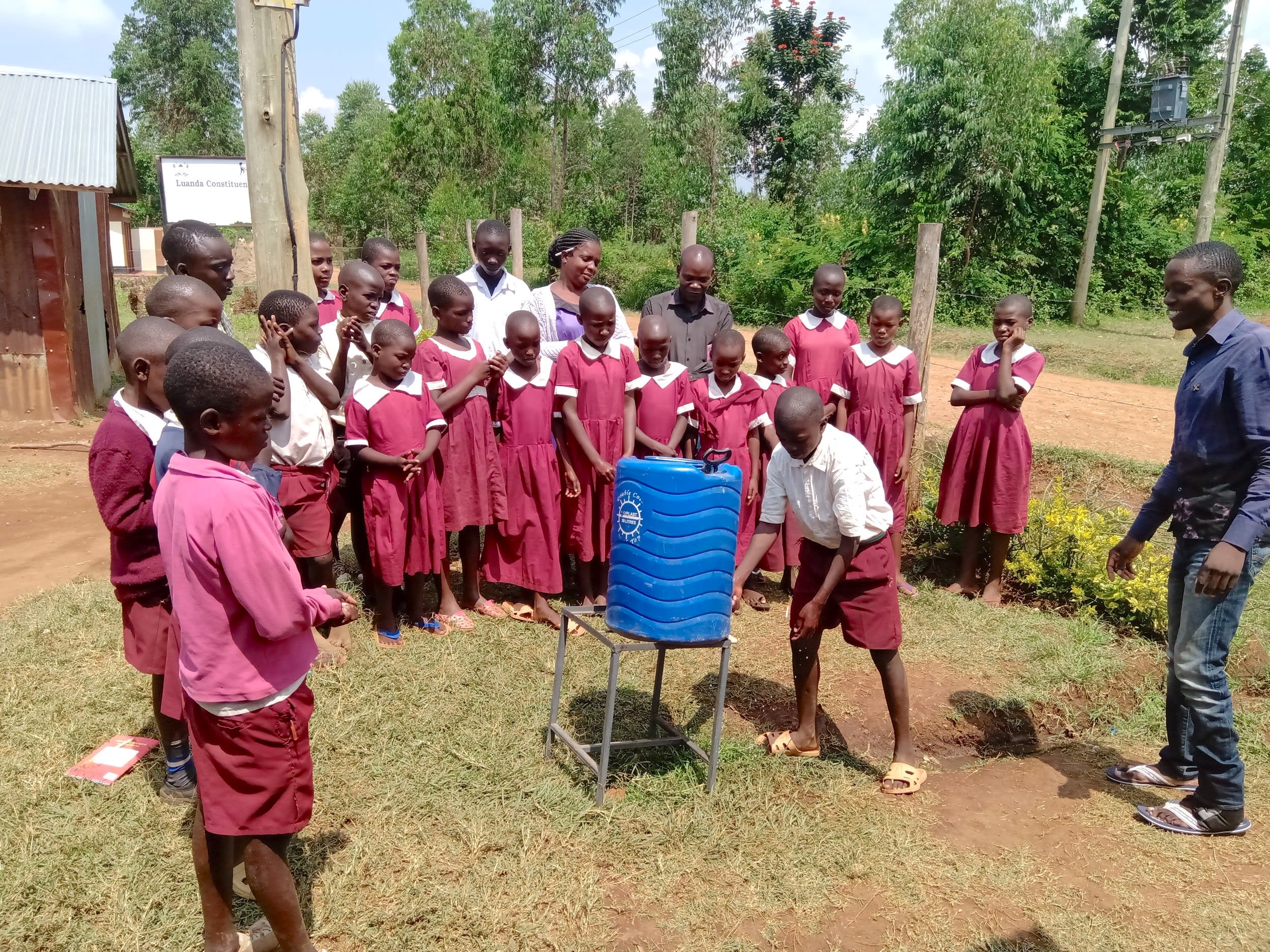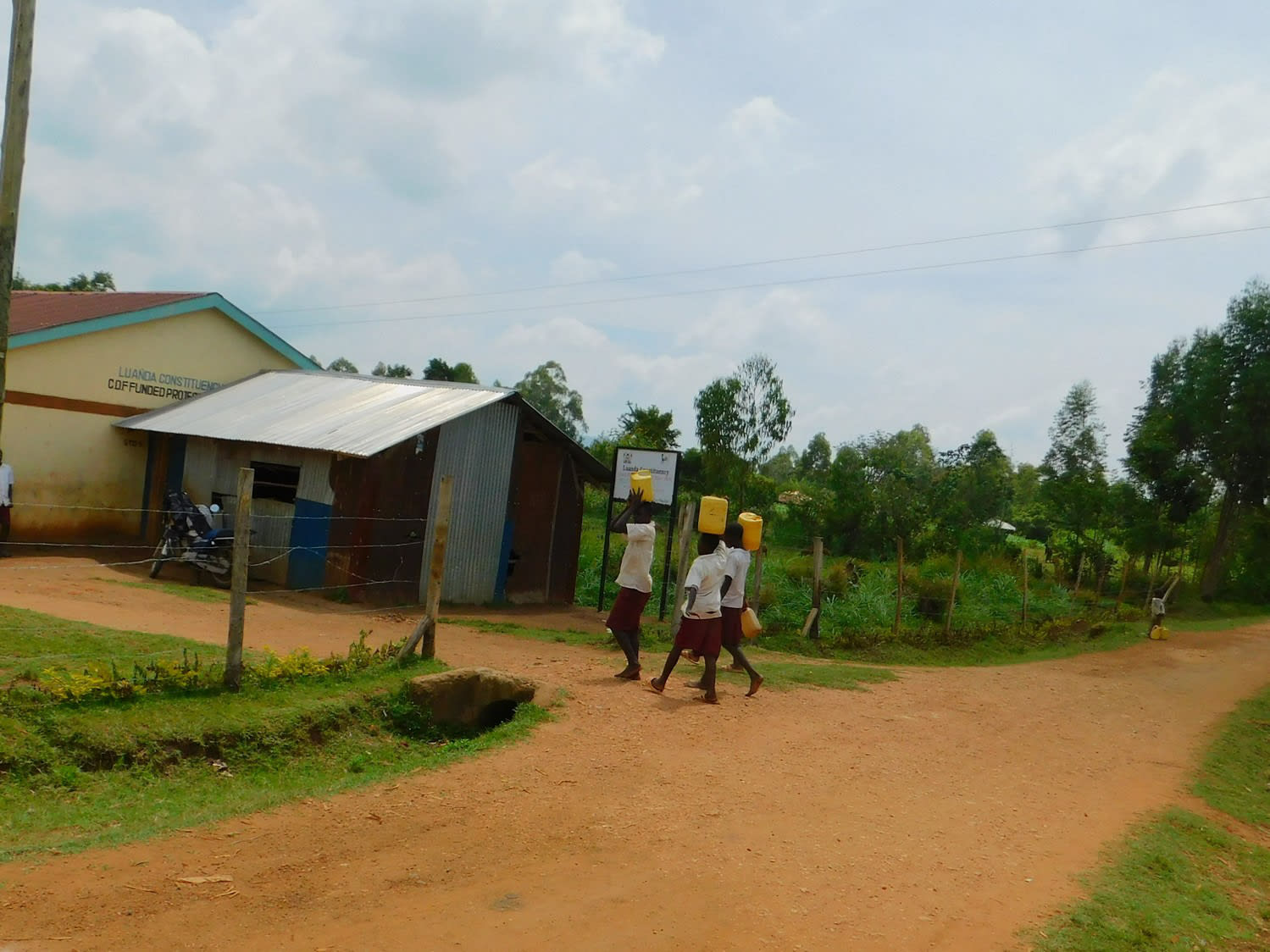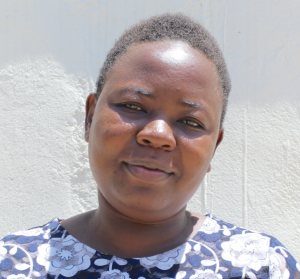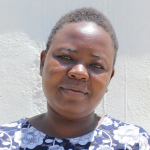February, 2020: Mulwanda Mixed Primary School Project Complete!
Mulwanda Mixed Primary School in Kenya now has access to a new source of safe, clean water thanks to the completion of their rain tank, which has the ability to collect 50,000 liters of water. We installed new latrines and handwashing stations for students, and we trained students and staff on improved sanitation and hygiene practices. All of these components work together to unlock the opportunity for these students to live better, healthier lives.

Student gives thumbs up for clean water in front of the new rain tank
Rain Tank
Construction for this 50,000-liter rain tank was successful!
Parents, staff, and students helped our artisans gather everything needed for construction. All the while, the school cooks prepared meals for the artisans, and the school provided accommodations for the artisans during their work. Local women and men helped our artisans with their manual labor, too.

Students help carry stones to the construction site
The process officially began with our staff and school administration looking around the school compound to try and determine the best location for a new rain tank. This needed to be the best site with good, clean roofing to catch the rainwater.
Then, we cleared the site by excavating the soil within the required measurements to make level ground for the tank foundation. The foundation was cast by laying hardcore on level ground and then reinforcing it using steel, concrete and waterproof cement.

Artisan works on the interior support pillar of the rain tank
Both the drawing pipe as well as the washout pipe were affixed as the foundation was laid. The wall was built with ferro-cement techniques through 6 layers. The inner wall was plastered while rough casting was done on the outer part. Finally, the catchment area was dug, plastered, and a staircase installed.
Dome construction could begin after the superstructure had been given enough time to settle. The manhole cover was fitted, inlet pipes were connected to the roof gutters, inlet screens, ventilation pipes (breathers) and overflow pipes were all done to standard. The greatest challenge experience was the quality of the sand for the tank. The only challenge the artisan experienced in the entire construction process was having to wait for the school to provide higher quality sand than what had originally been provided on-site, but this hurdle was quickly overcome.

Student enjoys a fresh drink from the rain tank
Once finished, the tank was given 3 weeks to undergo complete curing before it was cleaned and handed over to Mulwanda Mixed Primary School, though we will continue to offer them unmatchable support as a part of our monitoring and maintenance program.
"However much the school has a very tiny compound, they were able to stand together with the organization and ensure that the project was a success and that the students were able to save time and money with the presence of clean water in their school. It was humbling to see the level of togetherness and harmony between the school administration, the artisans, and the parents," said Field Officer Betty Majani reflecting on this project's success.
"May Almighty God richly bless...all the donors who sacrificed a lot of resources to ensure that the pupils of Mulwanda Mixed Primary School access safe, clean drinking water within their compound, sound sanitation, as well as proper hygiene practices like handwashing with soap," Betty said.

Students pose with the rain tank
The students and staff were very excited to begin using their tank once the water started flowing.
"I want to appreciate your team for this project. We will now have enough time to study and improve our grades," said student Wanyonyi.
VIP Latrines
This project funded the installation of 6 new ventilated improved pit (VIP) latrines, half for girls and half for boys.

Girls pose in front of their new latrines
All of these new latrines have cement floors that are designed to be easy to use and clean. And with a rain tank right on school property, there should be enough water to keep them clean.

Boys say "Thank you!" for their new latrines
Handwashing Stations
The 2 handwashing stations were delivered to the school and handed over to the student health club. These were placed outside of the girls’ and boys’ latrines to encourage handwashing after latrine use.

A student uses a handwashing station
Health club members teach other students how to properly wash their hands at the stations, make sure the stations are filled with water and work to ensure that there is always soap or ash available.
New Knowledge
Hygiene and sanitation training was scheduled with the help of the school principal and the head teacher, Mr. Peter Atira, who together helped ensure that the training date would be convenient for students, staff, and parent representatives. Individual teachers helped by selecting students from each class to represent the others.
When we arrived at the school, the teachers and pupils were about to finish partaking in their tea break and everyone was happy to see us as they were eagerly waiting for us for the training. It was a hot and sunny day that everyone in the school was excited about. The administration organized for us to meet in one of the classrooms, which had been thoroughly cleaned in advance and was well ventilated. There were seats well arranged and enough sunlight inside, thus making the environment so conducive for learning. 23 students and teachers attended the event.

We had a full house for training!
We covered a number of topics, including personal hygiene such as bathing, oral hygiene, and handwashing with soap as a barrier from germs; and operation and maintenance of the new facilities, with each person understanding their role for long-lasting clean water and good health. The new student health club will be greatly involved in project management and will be responsible for encouraging good health and hygiene practices amongst their peers, teachers, and the larger community.
The training was so vibrant since the participants who comprised of both teachers and pupils were so active by asking questions and answering questions posed by facilitators. This made the entire training so interesting.

A student reports her group's answers after a break-out session
The dental hygiene session was of particular interest to the group. First, Facilitator Betty Majani asked participants to show how they normally brush their teeth followed by her own demonstration of the proper method. Betty then asked everyone to imitate the steps she showed, and we saw that all of the participants were able to do the same.
It was exciting to see the participants try out the new method of brushing teeth and instantly pick it up while being shocked to find out that they had been doing it the wrong way before.

Handwashing demonstration
In the handwashing practical when everyone got the chance to try the 10 steps of handwashing the facilitators demonstrated, both teachers and pupils were so glad to learn a new version of the hygiene practice. The practical session was fun as everyone had a comment or an opinion to throw in which made it even more interesting.

A student tries out the handwashing station
Within each session wherever applicable, we also covered local alternatives for cleaning agents so that the cost of market-bought materials could not be a barrier for maintaining good hygiene. For example, in place of toothpaste one can use ash or salt, and ash is also a good substitute when no soap is available for handwashing.
"I want to take this opportunity to show my gratitude for enlightening us on how we can use locally available materials like ash to clean our latrines," said teacher Lidia Chitwa.
"The training will have a profound impact on [participants'] lives both at school and at home," said Betty Majani, the lead Field Officer and Trainer for this project.
"They now know high standards of hygiene in different aspects of life and promised to embrace them like the 10 steps of handwashing."
Thank you for making all of this possible!



 Rainwater Catchment
Rainwater Catchment
 Rehabilitation Project
Rehabilitation Project


































